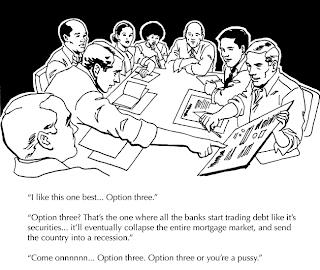Derivatives "Reform" or "Let’s Just Pretend It Isn’t a Problem but Act Like We Fixed It"?
Courtesy of Jr. Deputy Accountant
[click on images/tables to enlarge]
Pic credit: MTTS
A-ha! I f**king love "reform" in this country. God bless America!
Three of the five U.S. banks that dominate swaps trading already perform most transactions outside their depository institutions and would face minimal disruption from a congressional proposal to reorder the derivatives business, financial statements and banking records show.
JPMorgan Chase & Co. and Citigroup Inc. would be hit hardest by the proposal, crafted by Arkansas Senator Blanche Lincoln, to wall off swaps desks from commercial banks. JPMorgan had 98 percent of its $142 billion in current value derivatives holdings inside its bank in the first quarter of this year while Citigroup had 89 percent of $112 billion, the records show.
Morgan Stanley and Goldman Sachs Group Inc., each of which entered the commercial banking business in 2008 in the midst of the financial crisis, would be less affected. Morgan Stanley kept just over 1 percent of its $86 billion in derivatives holdings in its bank in the first quarter, and Goldman Sachs Group’s held 32 percent of its $104 billion. Bank of America Corp., which absorbed broker-dealer Merrill Lynch in 2009, had 33 percent of its $115 billion in its bank.
Now might be a good time to introduce a handy chart that shows the latest OCC data on derivatives exposure, or, more specifically, shows the concentration of said derivatives exposure among FIVE banks. You know, that would be the five banks that Blanche Lincoln might have wanted to target with this "reform" plan of hers. Just sayin, cue chart:
And let’s see, just who are those five banks?
JP Morgan, Bank of America, Goldman Sachs, Citi, and Wells Fargo eh? Well four out of five ain’t bad except that fifth is a b#*ch, how on Earth does Goldman get to weasel out of this?
From the OCC report:
The report shows that the notional amount of derivatives held by insured U.S. commercial banks increased by $8.5 trillion (or 4.2 percent) in the fourth quarter to $212.8 trillion. Interest rate contracts increased $7 trillion to $179.6 trillion, while credit derivatives increased 8 percent to $14 trillion.
The report also noted that:
- Banks hold collateral to cover 67% of their NCCE. The quality of the collateral is very high, as 81% is cash (US dollar and non-dollar).
- Derivatives contracts are concentrated in a small number of institutions. The largest five banks hold 97 percent of the total notional amount of derivatives, while the largest 25 banks hold nearly 100 percent.
- Credit default swaps are the dominant product in the credit derivatives market, representing 98 percent of total credit derivatives.
- The number of commercial banks holding derivatives decreased by 35 in the quarter to 1,030.
The above chart is meaningless if you aren’t intimately acquainted with these firms’ RBC numbers so let’s instead use something we all know: dollars. Keep in mind these are expressed in millions, and as we all know millions of millions are trillions. Moving on, let’s peek at the top 25 commercial banks:
So that’s $78 TRILLION for JP Morgan, with Bank of America lamely limping behind at $44 trillion. The bank holding company top 25 is even better:
So um what was that about "reform" again? Good luck with that!



